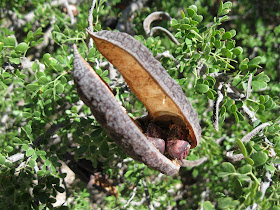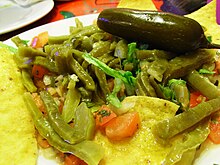While sailing down the east coast of Baja California, we were constantly surprised by the density and diversity of plants in what appeared to be essentially a desert. Up close and personal, there were times we regretted wearing shorts as almost all the trees, shrubs, and ground cover appeared armed with barbs, thorns or burrs. Chris seemed to be most Cacto-phyllic as he invariably stepped on or into these iconic symbols of the desert. While we recognized some of the more common plants, we really did not have a great reference book until this year. Our friend Randall of S/V Murre gave us the most valuable “ A Field Guide To The Common And Interesting Plants Of Baja California ” by Jeannet Coyle and Norman C. Roberts. So, now our hikes have become more interesting and occasionally we dare to taste some of the edible fruits and plants enjoyed by the indigenous people of the region many centuries ago.
 |
| Phytogeographic Regions of Baja |
As you can see on the map copied from the field guide, there are eight phytogeographic regions in Baja and we have only accessed one of them during Ladybug's travels this year – the Central Gulf Coast Desert. This region extends from the Bahia de los Angeles to the Cape and includes most of the Gulf Islands. As you have probably seen in many photos from our blog, the land here consists mainly of volcanic and granitic rock. The rainfall is irregular and sparse, resulting in sporadic flowering and growth of vegetation. Arriving last year in October, we saw a much greener desert after the summer rains.
 |
| Mallow Family |
The characteristics of the desert are low humidity, high air temperature, with great daily fluctuations, high surface and soil temperatures, low organic and high mineral content of the soil, erosion by strong winds and water, and poor drainage. Since water is essential to any life, desert plants have become highly adapted to preserving water. Examples are: a sprawling root system (creosote ), miniscule leaf size (ocotillio and cirio), thorns and spines instead of leaves (cacti) , resin and wax coatings for water-proofing (creosote ), leaf production limited to when water is available ( elephant tree ), bitter juices to avoid being eaten ( creosote, lomboy), tough seed coats and water storage tissue ( cactus, Agave ).
 |
Hedgehog Cactus in flower
|
 |
Tough, woody seed pod
|
Most desert plants are low in stature and are widely spaced, mingling with dissimilar plants – a lesson in harmony. Due to the limited nutrients and water, desert perennials grow very very slowly. The cardon is estimated to grow about one inch per year, so you can see why we worshipped the “old growth” sentinels which we encountered along the way.
 |
This old grandfather must be over 300 years old!
|
 |
| Torote Blanco - Elephant Tree |
The aromatic scent of the torote trees remind me of hikes in the pine and cedar forests of the northwest. The bark is used for tanning and dyeing.
 |
| Wild Lilac – leaves and flowers can be boiled into a tea. Fresh flowers make a lather when crushed and rubbed in water. Cattle, sheep and deer like it. Bees visit the flowers for nectar. |
 |
| Garambullo ( Old Man Cactus) - the tips of the stems are covered in coarse, gray hair-like spines. |
 |
| Cholla – Green, fleshy fruit was bitter to us but is popular with cows. We spent many hours trying to pick out the fine spines from our lips and hands after this taste test! |
 |
Devil's Claw – The woody seed pod has prong-like claws which attach to fur, clothing and skin for a highly effective dispersal method. The two claws often clamp into cattle nostrils or hikers' boots!
|
 |
| Juanita – Blooms continuously with pink flowers forming garlands over cacti and shrubs in arroyos and hills. |
 |
| Desert Mistletoe |
Desert Mistletoe ( Toji ) is a woody parasite that we see latched onto many trees. Its berries are eaten by birds or dried and eaten by Indians. Leaves and berries are also cooked with rice and the mixture used as a poultice to draw out pus from boils.
 |
| Pitaya Dulce |
Missionary records state that the Indians spent the Pitaya Dulce fruit season in a state of euphoria. It was a dangerous period for young girls gathering fruit as the braves would try to catch them. The feasting lasted several months and allowed the tribes to travel and socialize together. If the fruit was not eaten fresh, it could be dried for future use. Interestingly, when the fruit was gone, the indians would gather their dried feces to collect the black seeds, then grind these into a meal – the “second pitahaya harvest”.
 |
Blooming Barrel Cactus
|
 |
Bursage ( Burro weed )?
|
 |
| Nopal - Prickly Pear Cactus |
Nopales are generally sold fresh in Mexico, the spines removed and diced. Used to prepare nopalitos, they have a light, slightly tart flavor, like green beans, and a sticky texture.
 |
| Yummy! |
 |
| Torote Colorado - birds love this fruit |
 |
| These berries looked enticing but we knew better! |
 |
| Beautiful patterns on Barrel Cactus |
 |
| Flowers of the Desert Agave |
 |
| Cardon Cactus in bloom |
 |
| Red chilli-shaped flowers of Palo Adan - a very common shrub in the Baja |
 |
| Possibly Heronbill but I am not at all sure - comments? |
 |
| Brittlebush - Sunflower family |
 |
| Bird's nest with built-in spiny defense courtesy of Chain-Link Cholla |
 |
| Mangrove tree at Caleta Los Lobos |
 |
Nightshade
|
 |
Acanthus family
|
 |
| The underwater plants off the desert coast can be just as colourful! This photo was taken by Randall (sv Murre) while snorkeling at El Gato |






























While I have lived in the mossy maritime Pacific Northwest for nearly 20 years, I lived in and loved the Arizona-Sonora desert for just as long, so I found your latest entry very interesting. While I am intimately familiar with many of the species you described, a lot of them are unknown to me. It's funny how, even with my desert-rat heritage, I end up learning things about it from seagoing folks of the Great White North!?
ReplyDelete“Cacto-phyllic” Haha! I have no idea what phyllic means, but your context is clear. Chris will learn tricks as he gets pricked along the way. For example,whenever I hiked in the desert I always carried three tools: A comb, a pair of pliers and matches. A comb to remove the “jumping cactus” segments and pliers to pull the individual thorns that won't otherwise let go. A puppy's first hike invariably featured paws inflicted by cholla. It would then get all through their mouths as they instinctively tried to remove them! I have fond memories of using vice grips to pull thorns from the bloody gums of whining puppies. Their second hikes were usually less eventful, depending on the breed. The matches were for the fine, hairlike nasties of the prickly pear. They get in your jeans by the thousands, seemingly borne by the wind, and are quite agitating. Running a flame around the offending area sears them off. Also, you would've had more luck sampling the fruit had you burned the thorns first. Lots of little tricks. . .
I have always felt that the term “desert” was a misnomer. The diversity and density of unusual and fantastically beautiful life – at least in Northern Sonora and Southern Arizona – is far from “deserted.”
Geez, sorry to take up so much band width. Keep the posts coming.
Stephen / Jean
s/v Mytic